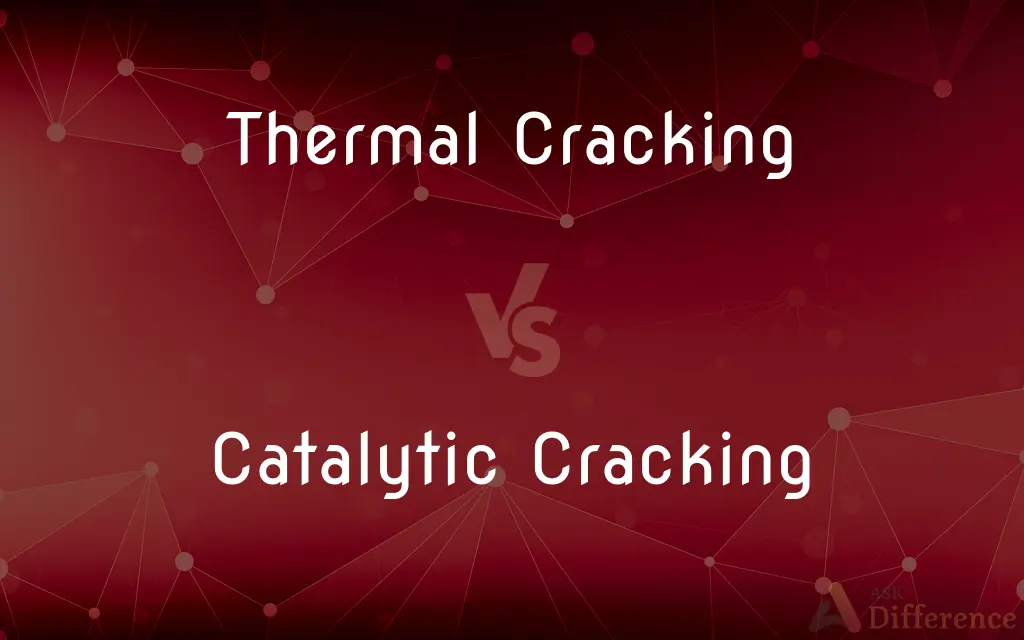Thermal Cracking vs. Catalytic Cracking — What's the Difference?
Edited by Tayyaba Rehman — By Fiza Rafique — Published on December 8, 2023
Thermal Cracking breaks hydrocarbons using heat; Catalytic Cracking uses heat and catalysts for finer products.

Difference Between Thermal Cracking and Catalytic Cracking
Table of Contents
ADVERTISEMENT
Key Differences
Thermal Cracking and Catalytic Cracking are both methods used in the petroleum industry to break down large hydrocarbon molecules. However, their mechanisms and outcomes differ substantially.
Thermal Cracking involves using high temperatures to break hydrocarbon molecules. The primary objective of this process is to produce more valuable light oils by splitting heavier molecules. In contrast, Catalytic Cracking uses not just heat, but also a catalyst to facilitate the cracking process, aiming to obtain a better yield of gasoline or other light hydrocarbons.
The products of Thermal Cracking usually have a more extensive range and are often less stable than those of Catalytic Cracking. This is because the absence of a catalyst in Thermal Cracking can lead to less controlled reactions. Meanwhile, Catalytic Cracking offers better control over the product's distribution due to the selectivity of the catalyst used.
Thermal Cracking operates at much higher pressures compared to Catalytic Cracking. This high pressure, combined with elevated temperatures, makes the process more energy-intensive. Catalytic Cracking, with the aid of catalysts, can operate under milder conditions, making it more energy-efficient.
In conclusion, while both Thermal Cracking and Catalytic Cracking aim to convert heavy hydrocarbons into lighter, more valuable products, their methods, operating conditions, and outcomes differ. The choice between them often depends on the desired product slate and efficiency.
ADVERTISEMENT
Comparison Chart
Mechanism
Heat only
Heat and catalysts
Operating Pressure
Higher
Lower
Product Stability
Less stable
More stable
Efficiency
Generally lower
Higher due to catalysts
End Products
Broader range
Finer, controlled products
Compare with Definitions
Thermal Cracking
High pressure, high temperature process,
The rigors of Thermal Cracking involve both high pressure and heat.
Catalytic Cracking
Uses catalysts to crack hydrocarbons.
Catalytic Cracking employs specialized catalysts to facilitate the breaking of molecules.
Thermal Cracking
Method to produce light oils.
The goal of Thermal Cracking is often to derive lighter oils from heavy residues.
Catalytic Cracking
High selectivity and control.
The products from Catalytic Cracking are more controlled, owing to the catalyst's specificity.
Thermal Cracking
Breaking hydrocarbons using high heat.
Thermal Cracking operates at extreme temperatures to split hydrocarbons.
Catalytic Cracking
Energy efficient process.
Catalytic Cracking offers a more energy-saving approach to hydrocarbon processing.
Thermal Cracking
Produces a broader range of products.
Through Thermal Cracking, a wide variety of hydrocarbons can be generated.
Catalytic Cracking
Operates at milder conditions.
Thanks to catalysts, Catalytic Cracking can function under less severe conditions.
Thermal Cracking
Absence of catalysts.
Unlike other methods, Thermal Cracking doesn't employ catalysts.
Catalytic Cracking
Method to produce gasoline.
Refineries often use Catalytic Cracking to boost gasoline yields.
Common Curiosities
Why is Catalytic Cracking more energy efficient?
The use of catalysts in Catalytic Cracking allows for milder operating conditions.
What is Thermal Cracking?
Thermal Cracking is a process using heat to break down large hydrocarbon molecules.
Why choose Thermal Cracking over Catalytic Cracking?
Thermal Cracking may be chosen for certain heavy residues or where catalysts are not available.
How do catalysts in Catalytic Cracking work?
Catalysts facilitate and speed up the hydrocarbon breaking process while offering control over product formation.
How does Catalytic Cracking differ?
Catalytic Cracking uses both heat and catalysts for a more controlled breakdown of hydrocarbons.
Are the products from Catalytic Cracking better?
Catalytic Cracking often produces more stable and controlled products than Thermal Cracking.
What products result from Thermal Cracking?
Thermal Cracking yields a broad range, from gases to heavy oils.
Why are catalysts not used in Thermal Cracking?
Thermal Cracking relies solely on heat and pressure, eliminating the need for catalysts.
Can only heat be used in Catalytic Cracking?
While heat is essential, the defining feature of Catalytic Cracking is the use of catalysts.
Is Thermal Cracking outdated?
Not necessarily, though Catalytic Cracking is often preferred for its efficiency and product control.
Is Thermal Cracking safer than Catalytic Cracking?
Both have risks, but Thermal Cracking operates under higher pressures, posing specific challenges.
Which method is more environmentally friendly?
Catalytic Cracking is usually considered more eco-friendly due to its efficiency and reduced waste.
Do both methods produce diesel?
Both can yield diesel, but product slates vary based on feedstock and operating conditions.
Is gasoline produced from Catalytic Cracking?
Yes, Catalytic Cracking is a primary method to boost gasoline production in refineries.
Which method is more cost-effective?
Generally, Catalytic Cracking, due to its efficiency and valuable product yields.
Share Your Discovery

Previous Comparison
Unprotected Pick NBA vs. Protected Pick NBA
Next Comparison
End-stopped Line vs. EnjambmentAuthor Spotlight
Written by
Fiza RafiqueFiza Rafique is a skilled content writer at AskDifference.com, where she meticulously refines and enhances written pieces. Drawing from her vast editorial expertise, Fiza ensures clarity, accuracy, and precision in every article. Passionate about language, she continually seeks to elevate the quality of content for readers worldwide.
Edited by
Tayyaba RehmanTayyaba Rehman is a distinguished writer, currently serving as a primary contributor to askdifference.com. As a researcher in semantics and etymology, Tayyaba's passion for the complexity of languages and their distinctions has found a perfect home on the platform. Tayyaba delves into the intricacies of language, distinguishing between commonly confused words and phrases, thereby providing clarity for readers worldwide.














































